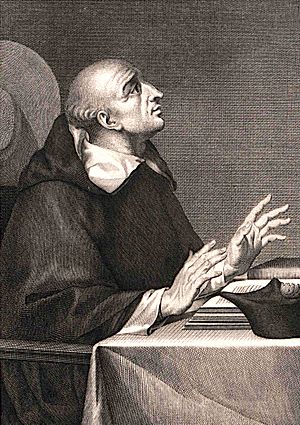Juan de Torquemada (cardinal) facts for kids
Juan de Torquemada (born in 1388 – died on September 26, 1468) was a Spanish church leader and a member of the Dominican Order. He was known for defending Jewish people who had converted to Christianity, called conversos. Many people considered him one of the best defenders of the Pope's power in the 1400s. He was also the uncle of Tomás de Torquemada, who later became famous as a strict Grand Inquisitor.
Contents
Life of Juan de Torquemada
Juan de Torquemada was born in Valladolid, Spain. Some historians believe his family had Jewish ancestors who converted to Christianity. However, studies of his family history have not found clear proof of this.
Early Life and Studies
When he was young, Juan joined the Dominican Order, a group of Catholic priests. He quickly became known for his intelligence and dedication. In 1415, he traveled with the head of his order to the Council of Constance, an important meeting of church leaders. After that, he went to the University of Paris to study. He earned his doctor's degree in theology in 1423. After teaching in Paris for some time, he became the leader (prior) of the Dominican houses in Valladolid and then in Toledo.
Role in Church Councils
Torquemada attended the Council of Basel (1431–1449). He represented his order and the King of Castile. At this council, he strongly supported Pope Eugene IV and the Roman curia (the Pope's administration). Because of his strong support, he was given important roles. He became the Master of the Sacred Palace in 1435. Later, in 1439, he was made a cardinal. A cardinal is a high-ranking church official, usually chosen by the Pope.
Torquemada also took part in the Council of Florence. There, he discussed important religious ideas with leaders from Eastern churches. He also defended the Pope's top authority in the Church. He worked for Pope Eugene IV on missions to Germany and France. Later, he settled in Rome. As a cardinal, he supported the Pope's plans for Crusades against the Ottoman Turks.
Defending the Conversos
In 1449, a new tax law in Toledo caused problems. A group of people rebelled and burned the house of a "new Christian" tax collector. "New Christians" were people of Jewish background who had become Christians. Some people doubted if they were truly Christian. A group led by Pedro Sarmiento created a law that stopped conversos from holding government or church jobs. It also prevented them from speaking in court. This made the legal standing of conversos very uncertain.
This issue spread beyond Castile and reached Pope Nicholas V. Juan de Torquemada urged the Pope to act. The Pope then issued a special order, called a papal bull, which spoke out against treating conversos unfairly. He also punished Sarmiento and his followers. In 1450, Torquemada wrote a strong paper. In it, he called Sarmiento and his group names from the Bible, comparing them to enemies of the Israelite people. He also compared them to Haman, a bad persecutor from the Bible. Torquemada's defense of conversos was successful in Rome. However, it did not fully succeed in Castile.
Defending the Pope's Authority
Juan de Torquemada was known as a great defender of the Pope's power in the 1400s. At that time, the Pope's authority was challenged by two main groups. One group was the Hussites, who were early Protestants. The other group was the conciliarists. They believed that a big meeting of church leaders (an ecumenical council) had more power than the Pope. The Council of Basel even tried to remove Pope Eugenius IV. Torquemada wrote a major work called Summa de ecclesia (1453). In it, he strongly argued against both these ideas.
Later Life and Legacy
Torquemada also worked to improve religious houses and monasteries. In 1456, Pope Callixtus III gave him the position of Abbot of the Santa Scolastica monastery in Subiaco. This connection might explain his interest in bringing printing to Rome. He wrote many books and papers supporting the Pope's leadership. His Summa de ecclesia was especially important. It defended the Church against the Hussites and the Pope against the conciliarists.
Torquemada held several important cardinal positions. He was a cardinal priest, then a cardinal bishop. He took part in four elections for a new Pope. He even cast the deciding vote in the election of Pope Nicholas V (1447–1455).
He died in Rome in 1468. He was buried at Santa Maria sopra Minerva. A painting by Antoniazzo Romano shows Torquemada helping girls who received money for their weddings from a group he started. He is shown presenting them to the Virgin Mary.
Works of Juan de Torquemada

Juan de Torquemada wrote many important books and papers. Here are some of his main works:
- Meditationes, seu Contemplationes devotissimae (Rome, 1467)
- In Gratiani Decretum commentarii (4 volumes, Venice, 1578)
- Expositio brevis et utilis super toto psalterio (Mainz, 1474)
- Quaestiones spirituales super evangelia totius anni (Brixen, 1498)
- Tractatus contra Madianitas et Ismaelitas: defensa de los judíos conversos (Burgos, 1957). This work defended Jewish converts.
- Summa ecclesiastica (Salamanca, 1550) or Summa de ecclesia (Venice, 1561). This major work defended the Church and the Pope's authority. It had several parts, including:
- De universa ecclesia (About the whole Church)
- De Ecclesia romana et pontificis primatu (About the Roman Church and the Pope's top authority)
- De universalibus conciliis (About universal church councils)
- De schismaticis et haereticis (About those who cause church divisions and heretics)
His book De conceptione deiparae Mariae, written in eight parts (Rome, 1547), was later edited by E. B. Pusey. Torquemada also wrote many other arguments and sermons.
His book Meditationes was special because it was the first book published in Italy that included illustrations. The first edition of this book was printed in 1467 in Rome by Ulrich Han.
See also
 In Spanish: Juan de Torquemada (cardenal) para niños
In Spanish: Juan de Torquemada (cardenal) para niños


